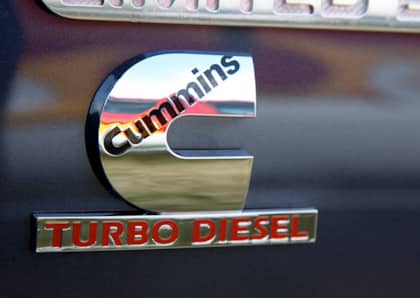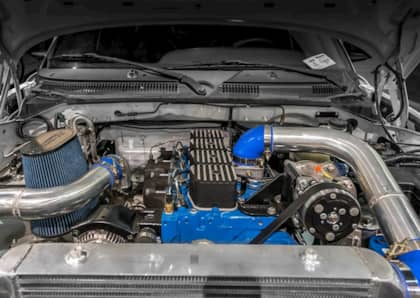4BT vs. R2.8—Which is the Better Small Displacement Cummins?
For nearly 20 years, the Cummins 4BT has been the compact diesel of choice in countless engine swaps, classic repowers and off-road projects. Its million-mile durability, mechanical simplicity and exceptional fuel efficiency make it a natural choice for anyone looking to build a fuel-sipping vehicle that will last forever. However, for the last two-and-a-half years it’s had some competition: the Cummins R2.8 crate engine—an even more packageable inline four cylinder that meets modern day emission standards and weighs nearly 300 pounds less. It’s electronically fueled and controlled, but Cummins removes the wiring headache from the equation by furnishing the R2.8 complete with an ECM and engine wiring harness—along with everything else you need to complete the install.
Still, while Cummins’ R2.8 engine represents the most comprehensive diesel crate engine package ever offered, it has had little impact on the 4BT swap craze. But why? Is it due to the 4BT’s direct ties to the legendary 6BT (i.e. the 12-valve 5.9L Cummins)? Or maybe it’s due to the relatively low cost of a used 4BT or its widespread availability? After all, the 4BT was introduced in 1983, so there is no shortage of usable core blocks, heads and various other parts laying around in junkyards or still bolted to abandoned bread vans, gen-sets and skid-steers. Taking all of the above into account, it’s time to pit these two engines against each other for the ultimate mini-Cummins face-off. From oil pan to turbocharger, we’ll lay out the facts—the final verdict is up to you.
| Cummins 4BT | Cummins R2.8 | |
|---|---|---|
| Displacement: | 239 ci (3.9L) | 171 ci (2.8L) |
| Bore: | 4.02-inch | 3.70-inch |
| Stroke: | 4.72-inch | 3.94-inch |
| Compression ratio: | 17.5:1 | 16.9:1 |
| Block: | Cast-iron | Cast-iron w/serviceable liners |
| Cylinder Head: | Cast-iron | Cast-iron |
| Valvetrain: | Single cam, overhead valves w/2 valves per cylinder | Chain-driven SOHC w/4 valves per cylinder |
| Fuel: | Direct injection, Bosch mechanical injection (rotary pump and then plunger pump) | Direct injection, Bosch high-pressure common-rail injection |
| Aspiration: | Natural, turbocharged and turbocharged and aftercooled (depending on application) | Turbocharged and aftercooled |
| Weight: | 782 lbs | 503 lbs |
| Oil capacity: | 10 quarts | 5.74 quarts |
| Horsepower: | 105 hp at 2,300 rpm (most common early power rating) | 161 hp at 3,600 rpm |
| Torque: | 265 lb-ft at 1,600 rpm (most common early torque rating) | 310 lb-ft at 1,800 rpm |
| Size: | 30.6” x 24.6” x 37.7”(L x W x H) | 25.1” x 25.0” x 28.3”(L x W x H) |
It’s Two-thirds 6BT

Essentially a 6BT Cummins with two cylinders chopped off, much of the love shown toward the 4BT engine is based on the 6BT’s ability to handle as much as 1,500 hp on factory-based components or its capacity to remain in operation for a million miles. The 4BT shares the same bore, stroke, forged-steel connecting rods, pistons, injectors and valvetrain parts with the 6BT, and all of these items can be interchanged. Adding to the engine’s reliability is the fact that everything is gear-driven (the camshaft, injection pump, accessory drive system etc.) so there is no timing chain or belt interval to worry about.
Torque Monsters, Given Their Size

Chronologically, the 4BT hit the streets before the 6BT and was originally released in July of 1983. It is commonly associated with the bread vans that used to roam all over America making deliveries, but the 4BT can also be found in countless gen-sets, small backhoe’s and skid-steers. Its cast-iron block and head construction makes for a simple yet robust foundation, and thanks to its 4.72-inch stroke better than a 2:1 torque-to-horsepower ratio is available. Like the 6BT, the 4BT is a low-rpm operator, with early versions of the engine rated for 105 hp at 2,300 rpm and 265 lb-ft of torque at 1,600 rpm. Later versions, specifically those equipped with the Bosch P7100 (“P-pump”) are capable of supporting nearly 200 hp with a few pump tweaks.
The Path to Big Power

Any 4BT has worth in the second-hand market, but finding one with a Bosch P7100 hanging off the side of it (rather than a rotary unit) is definitely the better find. The similar tweaks and parts available for the six-cylinder version of this mechanical plunger pump can be interchanged with this one, meaning solid performance gains can be had. Higher rpm governor springs, AFC and star wheel adjustments, a modified or discarded fuel plate and different rack plugs (to increase rack travel) all apply here just like they do on the 6BT.
4BT’s Are Cheaper…Or Are They?

On the surface and given their low-tech nature, the 4BT would seem like the more affordable option, but you’re not going to score one of these engines for a few hundred bucks anymore. To be sure, deals can still be found in some instances, but the cat is definitely out of the bag on the 4BT Cummins. For most running take-out engines, you’re looking at $1,500 to $3,500, and if you come to find out the engine needs an overhaul after the sale things can get expensive—fast. Other options include sourcing a brand-new crate engine, locating a surplus engine or buying a remanufactured 4BT from a reputable business.
The Perfect Fit

While many would prefer the 6BT Cummins to power their project(s), its size and weight is simply not feasible in smaller applications (Ford Rangers, Jeep Wranglers and old Toyotas to name a few). At 30.6 inches by 24.6 inches by 37.7 inches (L x W x H), the 4BT is much more suitable for engine bays with limited real estate. The fact that there are virtually no electronics to worry about is a deciding factor for many as well. After all, other than the injection pump the most complicated component you’ll find on a 4BT is its alternator. Another selling point is the adaptability the 4BT has with various transmissions. This engine was offered in GM, Ford and general industrial applications, so there are several bell housing options to choose from (also referred to as flywheel housings). The most common type of bell housing you’ll come across is the SAE #3, although SAE 2, 3 and 4 were all employed.
The Smallest ISF Cummins Produces: The R2.8

The R2.8 engine is from the ISF family of Cummins power plants and is the lightest offering within the group. Manufactured in China but assembled in America, the R2.8 is available in various vehicles throughout Asia and Europe (chassis cabs, small pickups, SUV’s, vans and industrial equipment), but only as a crate engine in the states. That said, it was the first factory-built diesel crate engine on the market. Given the popularity of the 4BT platform in countless engine swap projects in the United States, it’s clear that Cummins is looking to capitalize on that craze by offering a new-age, more-refined alternative to the engine it is no longer outright producing.
The “R” is for “Refined”

Pound for pound, the R2.8 outperforms most factory spec’d 4BT engines in terms of horsepower and torque despite having a considerably smaller displacement. The single overhead cam, four-valve head design certainly helps the engine breathe better and it’s more at home at higher rpm. But while the R2.8 doesn’t provide the off-idle, low-end grunt the 4BT does, a fairly well-matched Holset HE200WG turbocharger and common-rail injection technology help bring things to life in a reasonably quick (and significantly quieter) manner.
Just Add A Fuel Source, a Battery and Go!

With common-rail injection, an ECM and emissions equipment, the R2.8 is definitely more complicated than the 4BT. Thankfully, Cummins makes it easy by offering the aforementioned (and pre-calibrated) ECM, engine wiring harness, , accessory drive, power steering pump, cam-driven vacuum pump, 120-amp (internally regulated) alternator, starter, flywheel and even the accelerator pedal assembly to make your swap as painless as possible. The R2.8 crate package even includes a remote oil filter and fuel filter/water separator system. The only item we can think of that isn’t part of the deal is an A/C compressor—but there are provisions to accept one at the bottom of the block.
Emissions Equipment That Satisfies Tier 1 Standards

While some potential buyers may be turned off by the R2.8’s use of an exhaust recirculation system (EGR) and diesel oxidation catalyst (DOC), this allows the engine to meet EPA Tier 1 emission standards. In layman terms, that means you can install the R2.8 in any 1999 model year or older light-duty truck and be highway-legal. If anyone recalls, Tier 1 NOx standards were far lower than what they are today, which means the R2.8’s EGR system will likely be non-problematic.
Cylinder Liners (Pro) & Chain-Driven SOHC (Con)

One eye-opening fact about the R2.8 is that its cast-iron block is fitted with sleeves (i.e. liners). This is a big bonus for anyone who ends up having to service this engine in the field (or more likely, the trail). While the liners certainly add equity to the R2.8, the fact that it has a chain-driven single overhead camshaft steals some of that thunder. Cummins lovers have grown accustomed to all things being gear-driven, so having a wear item that’s guaranteed to warrant replacement some day is a hard sell for many die-hards.
Cost of Entry

Though the R2.8 has received lots of love from select media outlets, it is yet to have the kind of impact on the engine swap market many thought it would. In cost alone, the R2.8’s price tag is a drawback…but its MSRP has already come down to $7,699 (from $8,999). A completely rebuilt 4BT with a new block, head, valvetrain and pump can run you more than that…so if you’re comparing new to rebuilt it’s a toss-up. The real question is whether or not you want to power your project with new-age tech (common-rail injection, electronics, clean emissions) or stick with the tried-and-true mechanical mule that rattles, hums and shakes but rarely ever skips a beat.
You can’t buy it in crate form, but Cummins’ 3.8L ISF is perhaps even more comparable to the 4BT than the R2.8. Check out the stateside Jeep Wrangler we found with one under the hood right here.











